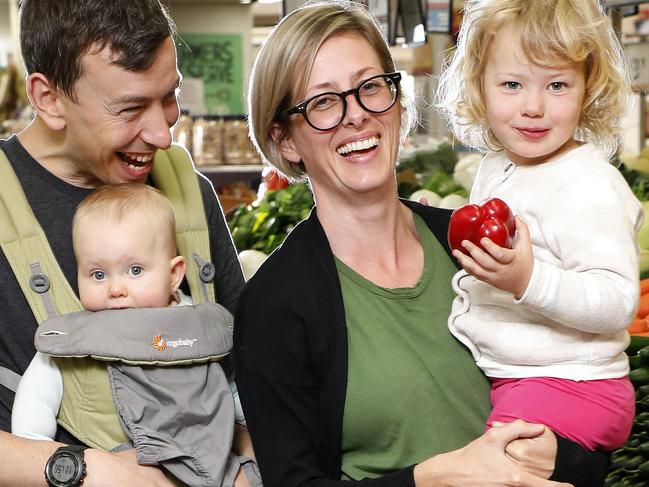Fruit and vegetable prices surge 9 per cent due to drought, new supermarket survey shows
THE big dry has begun to hit hip pockets, with the cost of fruit and vegetables soaring nine per cent in just three months. But some households are finding ways to keep bills in check.
Economy
Don't miss out on the headlines from Economy. Followed categories will be added to My News.
EXCLUSIVE: The big dry has begun to hit hip pockets, with the cost of fruit and vegetables soaring nine per cent in just three months.
A leading share analyst — who has been tracking prices since 2012 to help investors decide whether to buy or sell the stock of supermarket owners — recently wrote to clients saying the “drought affecting much of Australia’s growing regions” was a key reason for fresh food’s “prominent return to inflation” between July and October.
But in a welcome respite for households, Coles and Woolworths had “held back” on meat and seafood price increases, the analyst, Deutsche Bank’s Michael Simotas said.
The chains had done so despite the rising wholesale cost of chicken and red meat because they considered the “family shop to be centred on this category”, Mr Simotas said.
His analysis does not look at the dollar impact at the checkout. But if the chains are forced to pass on protein price rises, the hit could be $20 per trolley.
RELATED: Exclusive research reveals living standards threat

That’s bad news for consumers already contending with decade-high petrol prices that have made filling up a Corolla $20 a week more expensive than this time last year.
The good news is wage gains could be about to pick up by enough to outpace the rise in overall costs.
That would put living standards on the rise again after a recent fall.
Leading economist Stephen Roberts of Laminar Capital expects by the end of next year wage growth will reach 3.5 per cent and the consumer price index (CPI) three per cent — the upper limit of the RBA’s inflation target.
Both wage growth and the CPI are currently running at just above two per cent.
While Mr Roberts’s forecasts are more aggressive than many other economy-watchers, he said there is plenty of evidence to back up his views.

For example, in the 40 years in which unemployment data has been kept, the jobless rates in NSW and Victoria have hardly ever been lower.
That is creating wage pressure in industries such as construction, health services and the public sector.
“I think that we will get a more pronounced pick up in wages growth than most analysts are expecting,” Mr Roberts said.
He has also picked up a “dramatic change” in the cost of manufactured goods we bring in from countries such as China and the US.

These prices had been dropping by four to eight per cent a year.
“That had been helping to lower (overall) inflation,” Mr Roberts said. But now they are rising at three to five per cent.
In previous droughts, food inflation has hit twice the rate of general inflation.
Under Mr Roberts’s scenario, that could lead to a six per cent a year increase in the bill not just for fruit and vegetables but dairy goods, meat, bread and so on.
A typical family spends about $330 a week on food and non-alcoholic drinks, according to the Australian Bureau of Statistics. A six per cent increase adds $20 to that bill.
However, there should be some relief at the bowser in coming weeks as drops in international wholesale petrol markets flow through to local retail prices.
Shown the Deutsche Bank index, a Woolworths spokeswoman said “fresh food prices have remained relatively stable across the board, but we continue to monitor commodity markets and feedback from our industry partners closely.”
A Coles spokesman declined to comment on the index but said fruit and vegetable prices were coming off a low base.
A spokesman for Metcash, the owner of IGA — which was also part of the survey — said he could not comment.
Meantime petrol prices have reached $1.60 a litre in many parts of Australia recently compared to $1.20 a year ago. Economists say increasing transport costs are now beginning to feed into the food prices.

HOW INGLORIOUS FOOD SAVES MONEY, WASTE
MARY Conroy says her family “always” buys imperfect fruit and vegetables.
“There’s nothing wrong with it,” the Randwick mother of two said yesterday while shopping at Harris Farm.
“And we try to eat seasonally,” said Dan Khamoudes.
Ms Conroy said she and Mr Khamoudes spend “lots” on fresh food.
But, even so, after a couple of days they wonder where it’s all gone.
More and more households are joining them in taking advantage of the up to 50 per cent saving on ugly produce to keep costs in check.
“There is bucketloads of underlying demand,” said Harris Farm co-CEO Tristan Harris. “If we had 10 times as much we would sell it.”
A recent study by researchers from Queensland’s University of the Sunshine Coast found up to 87 per cent of “undamaged, edible, harvested tomatoes were rejected as outgrades and consequently discarded due to product specifications”.
Australia’s national food waste strategy is to halve what gets thrown out by 2030. The official document setting out how it can be done spotlights Harris Farm’s efforts to educate consumers about funky fruit and vegetables.
Reducing wastage is another key motivation for Ms Conroy and Mr Khamoudes in choosing imperfect produce.
In the US, this week a business named Imperfect Produce revealed basketball star Kevin Durant had taken a stake.
